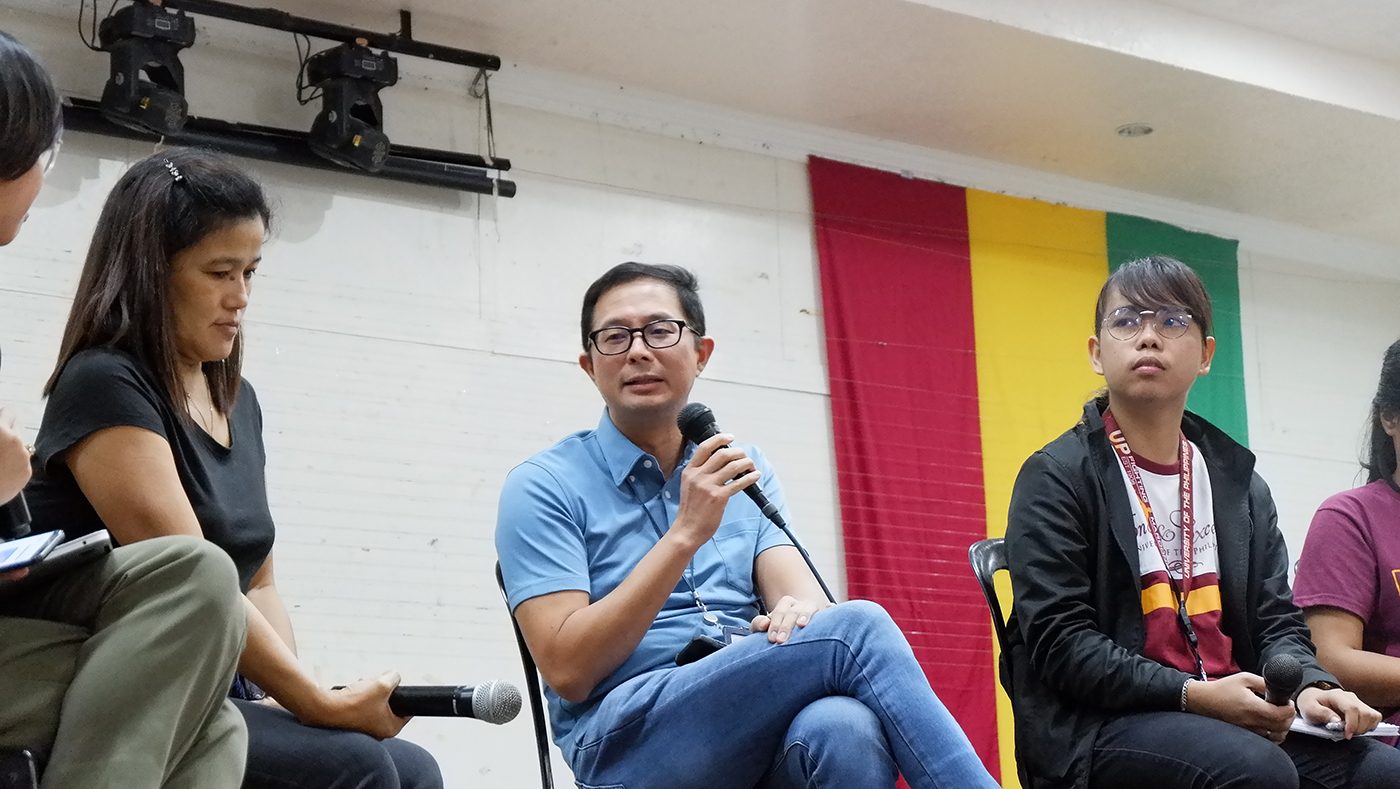SUMMARY
This is AI generated summarization, which may have errors. For context, always refer to the full article.

MANILA, Philippines – Long after Super Typhoon Yolanda (Haiyan) hit Tacloban City in 2013, hoaxes about disasters and calamities easily spread among residents as they continued to deal with the trauma brought by the catastrophic cyclone.
This is what panelists shared during the #MoveTacloban: Social Good in the Digital Age forum, as journalists, student leaders, and local government officials emphasized the need to fight misinformation during disaster-related events.
Led by Rappler’s civic engagement arm, MovePH, in partnership with UP Vista and UP Tacloban Student Council, #MoveTacloban tackled the dangers of disinformation and misinformation in a forum attended by 192 students and citizens at the University of the Philippines Visayas Tacloban College 3rd floor library on Wednesday, November 27.
Tacloban City Vice Mayor Jerry Yaokasin said that locals are especially vulnerable to hoaxes involving disasters due to what they experienced from Super Typhoon Yolanda.
Yolanda is considered by weather experts as perhaps one of the world’s most powerful typhoons in the past century. (READ: Most powerful 2013 storm hits PH)
Six years after the super typhoon killed thousands and devastated communities in Eastern Visayas, survivors said they are still mourning.
UP Vista Junior Staffer Justine Cuento added that these hoaxes, which usually crop up when a disaster strikes the area, tend to be easily believed by locals since they’re afraid of encountering the same traumatic experience from the super typhoon.
“I think people became scared of what’s going to happen to them, so they are taking very extreme precautionary measures just to avoid the Yolanda situation (from happening) again,” Cuento said.
Panic
Despite preparing for imminent disasters, they shared some Taclobanons are vulnerable to hoaxes and false information due to trauma they experienced from the super typhoon.
Among the hoaxes that came in the wake of Yolanda was a video about how the typhoon was created by “microwave pulses,” It is mentioned that weather can be manipulated, which is false as there are still no methods that can be effectively used for willful control of weather that is accepted by mainstream science. (READ: Did ‘microwave pulses’ create Yolanda (Haiyan)?)
Six years after Super Typhoon Yolanda, hoaxes still hound Tacloban City during disasters. Just recently, a magnitude 6.5 earthquake struck parts of the Visayas at 1:37 pm on Tuesday, April 23. This prompted evacuations among citizens of Samar, Tacloban City, Leyte, Bacolod City, Iloilo, and Cebu.
Rappler correspondent Jazmin Bonifacio shared that following the earthquake, several locals were stricken with fear after they heard somebody scream about a tsunami alert, despite an announcement from Philippine Institute of Volcanology and Seismology (Phivolcs) that was no tsunami threat present in the area. This hoax quickly spread like wildfire within the community, triggering unnecessary fear among the locals. (WATCH: ‘Fake news’ and the dilemma it has created)
“After nung lumindol, may sumigaw sa Wharf na may tsunami alert at nagtakbuhan ang mga tao. Ganoon siya kafast na naspread ‘yung information. May sumigaw lang,” Bonifacio recalled her experience during the earthquake.
(After the earthquake, there was a person who shouted that there was a tsunami alert, so people started running. That’s how fast misinformation is spread during disasters. It all started with shouting.)
Especially with trauma caused by Yolanda, panelists said residents tended to be vulnerable to panic-inciting hoaxes like this, especially if they did not have quick access to their phones and laptops for verification. (READ: Equating storm surge to tsunami ‘dangerous’ – expert)
“Nawitness ko ‘yung mga taong nagtatakbuhan and they were bringing all their belongings. May private vehicle na may megaphone and sinasabi na ‘umatras ‘yung tubig sa dagat and there will be a tsunami coming.’ At ako naman, wala akong source of information dahil wala akong internet sa phone ko, I panicked,” Aquino said.
(I witnessed people running and bringing all their belongings. There was a private vehicle with a megaphone, saying that a tsunami is coming for us. I don’t have any information about it because I didn’t have any internet on my phone so I panicked.)
UP Tacloban Student Council president Nikko Aquino stressed that given the situation, there should be more accessible disaster risk information on storm surges and tsunamis to make the community more knowledgeable about what to do and spot during these situations.
What should we do?
Bonifacio highlighted the need to verify information with government agencies involved and properly disseminate them to the public to avoid disaster-related misinformation and unnecessary panic.
“Information is an aid. Nakakatulong siya but if hindi natin mabigay ‘yung correct information sa public, puwede siya maging danger to the public,” Bonifacio said.
(Information is an aid for people. It is helpful but if we don’t give the correct information, it is dangerous to the public.)
Cuento pointed out that citizens need to be vigilant by being critical on issues happening within the community, and make the choice to fact check when in doubt.
“One of the pillars of UP Vista is that we should stand for the truth and stand for the people because people deserve the truth,” she said.
For Vice Mayor Yaokasin, locals need to be more courageous by telling the truth, especially in times where hoaxes can easily spread within their community due to what they’ve experienced.
“Do not be afraid to tell the truth. Do not be surprised when people are mad at you for telling the truth —those people are living a lie. Truth and transparency are important so that we can progress,” Yaokasin said. – Rappler.com
Add a comment
How does this make you feel?
There are no comments yet. Add your comment to start the conversation.